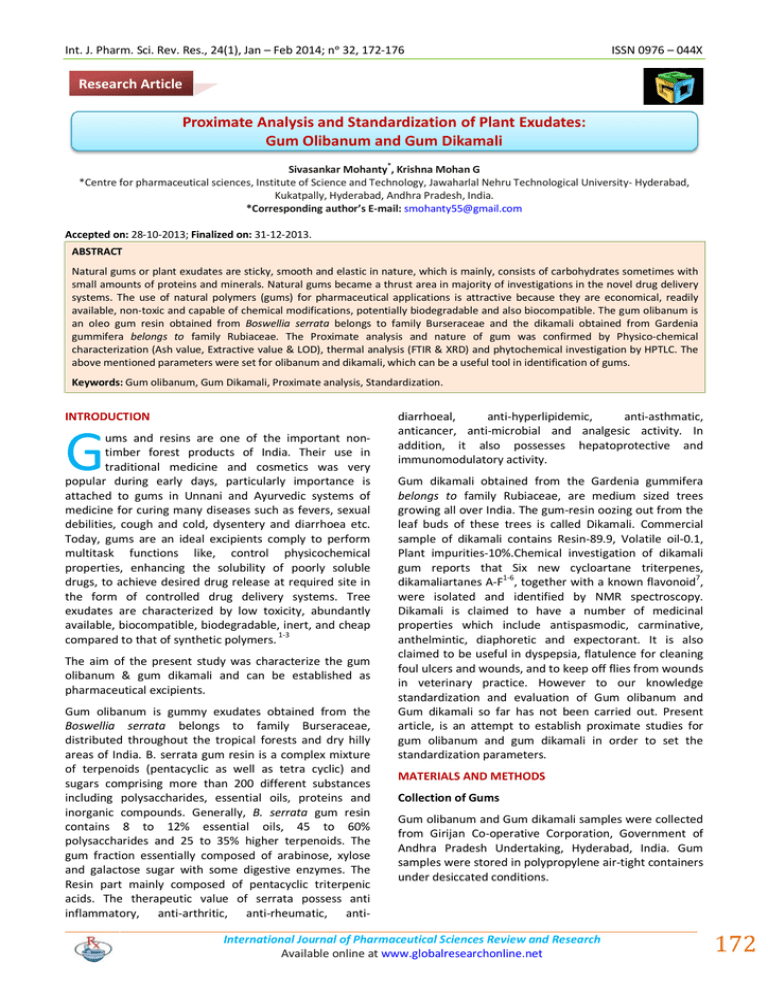Document 13309525
advertisement

Int. J. Pharm. Sci. Rev. Res., 24(1), Jan – Feb 2014; nᵒ 32, 172-176 ISSN 0976 – 044X Research Article Proximate Analysis and Standardization of Plant Exudates: Gum Olibanum and Gum Dikamali * Sivasankar Mohanty , Krishna Mohan G *Centre for pharmaceutical sciences, Institute of Science and Technology, Jawaharlal Nehru Technological University- Hyderabad, Kukatpally, Hyderabad, Andhra Pradesh, India. *Corresponding author’s E-mail: smohanty55@gmail.com Accepted on: 28-10-2013; Finalized on: 31-12-2013. ABSTRACT Natural gums or plant exudates are sticky, smooth and elastic in nature, which is mainly, consists of carbohydrates sometimes with small amounts of proteins and minerals. Natural gums became a thrust area in majority of investigations in the novel drug delivery systems. The use of natural polymers (gums) for pharmaceutical applications is attractive because they are economical, readily available, non-toxic and capable of chemical modifications, potentially biodegradable and also biocompatible. The gum olibanum is an oleo gum resin obtained from Boswellia serrata belongs to family Burseraceae and the dikamali obtained from Gardenia gummifera belongs to family Rubiaceae. The Proximate analysis and nature of gum was confirmed by Physico-chemical characterization (Ash value, Extractive value & LOD), thermal analysis (FTIR & XRD) and phytochemical investigation by HPTLC. The above mentioned parameters were set for olibanum and dikamali, which can be a useful tool in identification of gums. Keywords: Gum olibanum, Gum Dikamali, Proximate analysis, Standardization. INTRODUCTION G ums and resins are one of the important nontimber forest products of India. Their use in traditional medicine and cosmetics was very popular during early days, particularly importance is attached to gums in Unnani and Ayurvedic systems of medicine for curing many diseases such as fevers, sexual debilities, cough and cold, dysentery and diarrhoea etc. Today, gums are an ideal excipients comply to perform multitask functions like, control physicochemical properties, enhancing the solubility of poorly soluble drugs, to achieve desired drug release at required site in the form of controlled drug delivery systems. Tree exudates are characterized by low toxicity, abundantly available, biocompatible, biodegradable, inert, and cheap compared to that of synthetic polymers. 1-3 The aim of the present study was characterize the gum olibanum & gum dikamali and can be established as pharmaceutical excipients. Gum olibanum is gummy exudates obtained from the Boswellia serrata belongs to family Burseraceae, distributed throughout the tropical forests and dry hilly areas of India. B. serrata gum resin is a complex mixture of terpenoids (pentacyclic as well as tetra cyclic) and sugars comprising more than 200 different substances including polysaccharides, essential oils, proteins and inorganic compounds. Generally, B. serrata gum resin contains 8 to 12% essential oils, 45 to 60% polysaccharides and 25 to 35% higher terpenoids. The gum fraction essentially composed of arabinose, xylose and galactose sugar with some digestive enzymes. The Resin part mainly composed of pentacyclic triterpenic acids. The therapeutic value of serrata possess anti inflammatory, anti-arthritic, anti-rheumatic, anti- diarrhoeal, anti-hyperlipidemic, anti-asthmatic, anticancer, anti-microbial and analgesic activity. In addition, it also possesses hepatoprotective and immunomodulatory activity. Gum dikamali obtained from the Gardenia gummifera belongs to family Rubiaceae, are medium sized trees growing all over India. The gum-resin oozing out from the leaf buds of these trees is called Dikamali. Commercial sample of dikamali contains Resin-89.9, Volatile oil-0.1, Plant impurities-10%.Chemical investigation of dikamali gum reports that Six new cycloartane triterpenes, dikamaliartanes A-F1-6, together with a known flavonoid7, were isolated and identified by NMR spectroscopy. Dikamali is claimed to have a number of medicinal properties which include antispasmodic, carminative, anthelmintic, diaphoretic and expectorant. It is also claimed to be useful in dyspepsia, flatulence for cleaning foul ulcers and wounds, and to keep off flies from wounds in veterinary practice. However to our knowledge standardization and evaluation of Gum olibanum and Gum dikamali so far has not been carried out. Present article, is an attempt to establish proximate studies for gum olibanum and gum dikamali in order to set the standardization parameters. MATERIALS AND METHODS Collection of Gums Gum olibanum and Gum dikamali samples were collected from Girijan Co-operative Corporation, Government of Andhra Pradesh Undertaking, Hyderabad, India. Gum samples were stored in polypropylene air-tight containers under desiccated conditions. International Journal of Pharmaceutical Sciences Review and Research Available online at www.globalresearchonline.net 172 Int. J. Pharm. Sci. Rev. Res., 24(1), Jan – Feb 2014; nᵒ 32, 172-176 ISSN 0976 – 044X Proximate Studies Solubility test Solubility test The gum olibanum was not soluble in water but soluble in organic solvents like diethyl ether and became very sticky. The gum dikamali is not soluble in water but became mucilage. Purified Gum Olibanum and Gum dikamali were evaluated for solubility in water, diethyl ether, chloroform, acetone, and methanol in accordance with I.P. specifications. Ash values It is used to determine quality and purity of a crude drug. It is also used to determine the contents of inorganic radicals like phosphates, carbonates and silicates of sodium, potassium, magnesium, calcium etc. So water soluble ash, total ash, and acid insoluble ash were obtained by reported methods. Determination of Extractive Values The extractive value used to get the idea about the nature of the chemical constituents present in a crude drug. Extracts were prepared with various solvents by standard methods. Percentage yield for extracts was obtained. Determination of Moisture content Moisture content was determined as per I.P. specifications. 2 g of gum samples were transferred uniformly in the weighed Petri dishes and then dried in hot air oven at 1050C until a constant weight was obtained. The moisture content was determined as a ratio of weight of moisture loss to weight expressed as a percentage. Fluorescence Analysis Powdered gum samples were screened for fluorescence characteristic with or without chemical treatment. The observation pertaining to their colour under ultra-violet light and in day light were noticed and reported. Phytochemical analysis The phytochemical analysis was performed by HPTLC study. The TLC plates were prepared with gum extracts using different solvent like Diethyl ether, methanol, acetone, water & chloroform. Ash value The total ash, water soluble ash, and acid insoluble ash of Gum olibanum and Gum dikamali was carried out and presented in the Table 1. Table 1: Ash values of Gum olibanum and Gum dikamali Parameters Gum olibanum Total ash Gum dikamali 6.8 ± 0.06 7.2 ± 0.11 Acid insoluble ash 0.342 ± 0.03 0.281 ± 0.12 Water soluble ash 1.59 ± 0.023 3.31 ± 0.045 The values are expressed as mean± SD, n =4. Extractive Values The extractive values of Gum olibanum and Gum dikamali was carried out and presented in Table 2. Table 2: Extractive values of Gum olibanum and Gum dikamali Extracts Gum olibanum Gum dikamali Pet ether 3.44 ± 0.09 2.31 ± 0.03 Ethyl acetate 0.184 ± 0.02 0.192 ± 0.012 Chloroform 0.615 ± 0.113 0.914 ± 0.145 Acetone 2.91 ± 0.12 2.45 ± 0.11 Methanol 2.22 ± 0.149 3.41 ± 0.210 Moisture Content Moisture content is a key parameter which determines the quality, efficacy and shelf life of the plant derived drug and was confirmed by Loss on drying. Moisture content of Gum olibanum and Gum dikamali were found to be 10.17 ± 0.112% w/w and 13.70 ± 0.015% w/w respectively. Phytochemical screening Thermal analysis Thermal analysis was carried out by FTIR & XRD study. RESULTS AND DISCUSSION The phytochemical screening was carried out and the results were obtained as provided in table 4. High Performance Thin Layer Chromatography: The gums were standardized by pharmacognostic studies, physico-chemical properties, phytochemical analysis and thermal analysis. As the standardization is required to know about the constituents present in the gum sample and the usefulness in pharmaceutical formulations. Gum olibanum and Gum dikamali were standardized for their various parameters as part of evaluation and results are reported as follows. Chromatographic Conditions Stationary phase: Pre-coated silica gel plates, Merck 60 F254 Mobile phase: Benzene: methanol (95:5) Lamp: Deuterium Wavelength: 254 nm Application mode: CAMAG Automatic TLC Sampler III Development mode: CAMAG Twin Trough Chamber Scanner: CAMAG TLC Scanner 3 and WinCATS software International Journal of Pharmaceutical Sciences Review and Research Available online at www.globalresearchonline.net 173 Int. J. Pharm. Sci. Rev. Res., 24(1), Jan – Feb 2014; nᵒ 32, 172-176 ISSN 0976 – 044X Table 3: Fluorescence Analysis UV light Visible light Treatment Short wavelength Long wavelength GO GD GO GD GO GD powder white Greenish Yellow white Greenish Yellow purple Brown with blue spots Powder+ water white Greenish Yellow white Greenish Yellow white Greenish Yellow Powder + 5% sodium Hydroxide white Reddish brown white Reddish brown white Bright violet Reddish brown Yellow Light cream Yellow Cream purple Pink Powder + hydrochloric acid white Greenish Yellow white Greenish Yellow white Pale Pink Powder + benzene white L. Yellow white L. Yellow white Light Pink Powder + Acetone white L. Yellow white L. Yellow white Greenish Yellow Powder + Hexane white L. Yellow white L. Yellow white Greenish Yellow Powder + conc.sulphuric acid GO-Gum olibanum; GD-Gum dikamali. Table 4: Phytochemical screening results Test Test for Carbohydrates (Molisch’s test) Test for Gums (Ruthenium red) Gum olibanum + + Gum dikamali + + Test for Reducing sugars (Fehling’s test) Test for Glycosides(Killer-Killani test) Test for Alkaloids (Wagner test) Test for Steroids (Salkowski test) Test for Flavonoids (Shinoda test) + _ _ _ _ + _ _ _ + Test for Tannins (ferric chloride test) Treatment with iodine solution _ _ _ _ + Present, - Negative Figure 1: HPTLC of gum olibanum: HPTLC of gum dikamali: The Rf value was found to be for gum olibanum and gum dikamali as 0.12 & 0.78 respectively. Figure 2: FTIR of gum olibanum International Journal of Pharmaceutical Sciences Review and Research Available online at www.globalresearchonline.net 174 Int. J. Pharm. Sci. Rev. Res., 24(1), Jan – Feb 2014; nᵒ 32, 172-176 ISSN 0976 – 044X Figure 3: FTIR of gum dikamali Fourier Transformation Infra-red (FTIR) analysis Infrared spectroscopy was performed by FTIR study, Alpha Brooker FTIR (Tokyo, Japan).The ratio of sample to Kbr was 1:10. 1 In figure 2, 3422.37 cmˉ indicates the presence of –OHgroup.1705.33 cmˉ1 indicates the presence of carbonyl group. In figure 3, 3415.64 cmˉ1 indicates the presence of –OH1 group.2932.80 cmˉ indicates the presence of carboxylic group & 1619.43 cmˉ1 indicates carbonyl group. XRD Study It was carried out to know the crystal structure of the gum sample. XRD of gum olibanum XRD of gum dikamali Figure 4: XRD spectrums DISCUSSION The gum olibanum was not soluble in water but soluble in organic solvent and became more stickers where as the gum dikamali was not soluble in water but became mucilage. According to ash value, both the gums were showed the low levels of total ash and acid insoluble ash, which indicates the low levels of contamination during collection and handling of gums. The extractive value was more for gum dikamali in methanol, so it representing the presence of polar groups. The florescence analysis was carried out to avoid substitution or adulteration, gums were examined under day light (254 nm) and Ultra violet light (365 nm), which is helpful in identifying plant derived drugs from substitution or adulteration. The phytochemical screening showed the absence of glycosides, alkaloids, steroids and tannins but only flavonoid was present in gum dikamali and also supported by the carbohydrate test .The HPTLC study showed very good peak in benzene: methanol (95:5) mobile phase. The XRD study showed the crystalline structure of the gum. The above all parameter is need to establish a gum as pharmaceutical excipients. CONCLUSION Gum olibanum and Gum dikamali confirms positive tests for carbohydrates and reducing sugars. Moisture content of Gum olibanum and Gum dikamali were found to be low which would not support microbial growth and ensures longer shelf life of gums. Gum olibanum showed high extractive values with petroleum ether and gum dikamali showed high extractive value in methanol indicating the presence of non polar & polar compounds respectively and also justified by HPTLC results. The XRD study showed the crystalline nature of both the gums. The phytochemical analysis, florescence analysis and thermal analysis can very well be accepted as one of the standard method to analyzing the gums and also can be used as pharmaceutical excipients. International Journal of Pharmaceutical Sciences Review and Research Available online at www.globalresearchonline.net 175 Int. J. Pharm. Sci. Rev. Res., 24(1), Jan – Feb 2014; nᵒ 32, 172-176 ISSN 0976 – 044X 6. Quadry JS. Pharmacognosy. Evaluation of Natural Products and significance of Pharmacopoeial standards, CBS Publishers and Distributors Pvt Ltd, New Delhi,16, 2010, 32-39. 7. G. Sridhar Patwari, A. Rama Narsimha Reddy, A.V.N. Appa Rao and Y. Narsimha Reddy, International journal of applied biology and pharmaceutical technology, 2(4), 2011, 1-7. 8. Venkatesh Teja B, Bharath S, Deveswaran R, Basavaraj BV and Madhavan V, Modified emulsion technique for the micro encapsulation of Diclofenac sodium using gum olibanum as resin polymer, 1(2), 2012, 508-513. REFERENCES 1. Anonymous. Reviews on Indian medicinal plants, medicinal plant unit. Indian council of medical research, New Delhi, 2(200), 373-383. 2. Khandelwal KR. Practical Pharmacognosy, Nirali prakashan, Pune, 1, 2005, 149- 156. 3. Stahl E. Thin layer Chromatography: A Laboratory Handbook. Springer Publication, New York, 2, 2005, 807837. 4. Mukherjee PK. Quality control of Herbal Drugs. Development of Standardisation Parameters, Business Horizons, New Delhi.1, 2007, 184-245. 5. Ali M. Pharmacognosy and Phytochemistry. Quality control and standardisation, CBS publishers and Distributors Pvt Ltd New Delhi. 1, 2009, 181-211. Source of Support: Nil, Conflict of Interest: None. International Journal of Pharmaceutical Sciences Review and Research Available online at www.globalresearchonline.net 176



